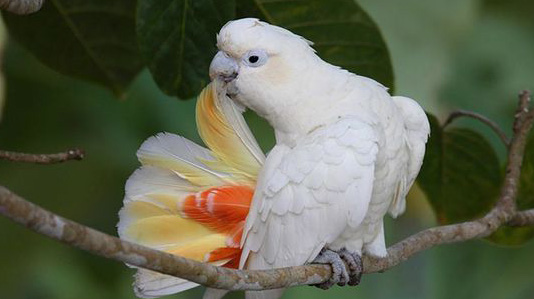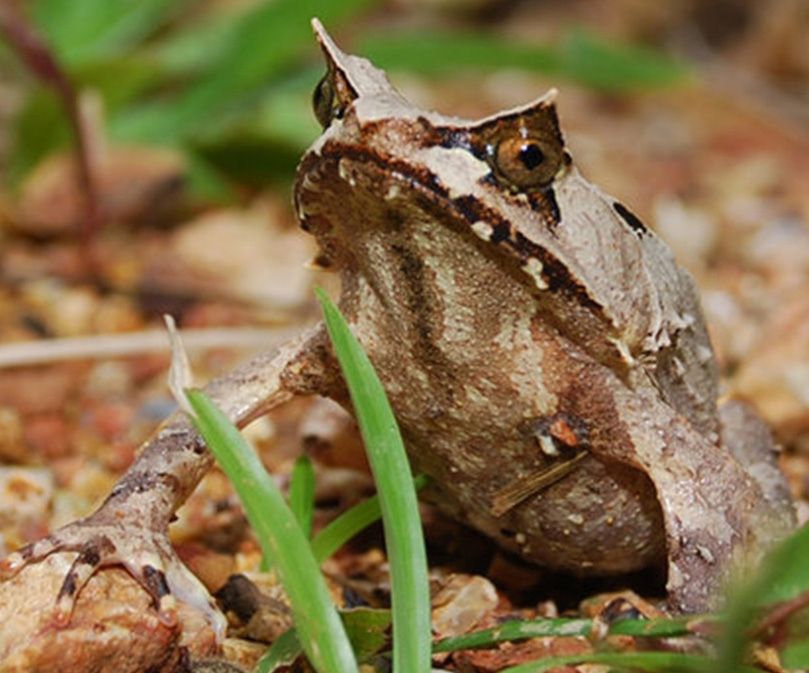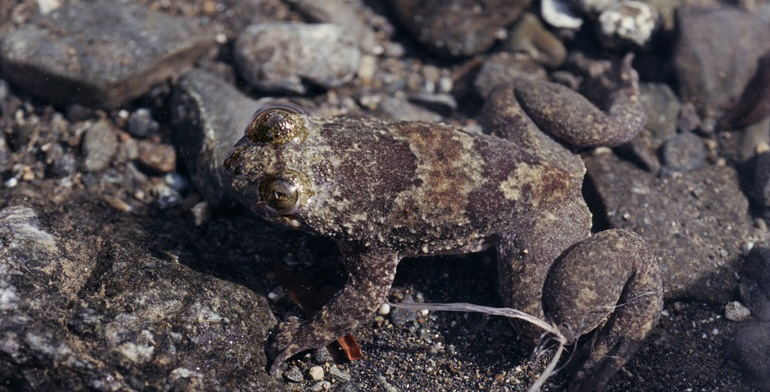The Cleopatra’s Needle Critical Habitat (CNCH) is home to many endemic species who are now part of the International Union for Conservation of Nature (IUCN) Red List of Threatened Species. The following are some of them, according to the Global Wildlife Conservation.
Philippine Cockatoo (Critically Endangered)
They are a long-lived species, noted to have a generational length of 13 years. Extensive deforestation and high demand as pets have contributed to a shrinking population.

They are small, white cockatoos with red and yellow markings under the tail. Adults have a crest, pinkish ear coverts, and lores, along with reddish and yellow markings beneath the wings and tail. Eye color is different, too, with younger cockatoos having grayer irises that develop into black-brown ones for males, red-tinted ones for females. They tend to have loud and startling calls when they do voice out. Also known as the red-vented cockatoo, this bird species is a social one, and they congregate in noisy groups for roosting and feeding. However, they pair off during the mating seasons, with mating pairs distancing themselves from the flock. They mainly feed on seeds, but they also eat fruits and flowers.
Palawan Forest Turtle (Critically Endangered)
Illegal trade is seen as this turtle’s biggest enemy, as they haven’t been studied enough yet to determine many aspects of their natural lives.
The Palawan forest turtle has an external shell that is reddish-brown to black, and can reach up to a little more than eight inches in length. Some individual turtles have been known to reach up to 12 inches, but these are considered to be rare. They have hooked upper jaws.

They are recognized by their projecting shell shape, armor plates that look like ginkgo leaves, and light line markings behind the main head area. They are omnivorous, meaning they can eat aquatic plants, small fish, and crustaceans. Historically, they were feared to be extinct until 2001 when specimens were found.
Palawan Horned Frog (Endangered)
According to Wildscreen Arkive, Palawan horned frogs are named because of two elongated horns, one on each upper eyelid. They have light brown to gray markings and have about two ridges running down their backs. The coloring and their other external details make them look like dead leaves. They have wide heads, with pointed snouts, with a fold of skin marking the separation of the head from the body. Their legs are somewhat short, and the feet in front are unwebbed, with the ones at the back having some webbing.

They are active all day and hop rather than jump. Not much is known about their diet in the wild but it probably consists of insects and smaller frogs. The males have a loud, mechanical-sounding call, heard during heavy rain. The females lay eggs in mountain streams and the tadpoles prefer quiet pools. Other than that, not much else is known about the life cycle of these frogs.
Palawan Toadlet (Endangered)
Little is known about their life cycle but they are known to prefer forests near streams, be they in the lowlands or towards the mountains. It is thought that habitat loss is their greatest enemy, hence the importance of the CNCH to the species.

The Palawan toadlet is also known as the white-striped flathead toad. Aside from the white stripes at the back, they also have a uniform cream color at the throat area. They are rather small, not even reaching an inch in size. Their external ear structures are easily seen.
Their reputation as a rare species is strengthened by the fact that they had only been seen once before 2014, marking a 40-year gap in sightings. They were “found” again during the study for Cleopatra’s Needle to be converted into a critical habitat, according to the Amphibian Survival Alliance website.
Philippine Flat-Headed Frog (Vulnerable)
The Philippine flat-headed frog is also known as the Busuanga jungle toad and the Philippine aquatic frog. The secretive nature of the animal, combined with what may be very specific environmental requirements, makes this species vulnerable to further changes in habitat.

Aside from Palawan, they are endemic also to Busuanga, Culion, and Balabac islands, according to a 2002 article by Carlos Infante for AmphibiaWeb.org. They are considered as large, heavy-bodied, and highly aquatic frogs, with nostrils and eyes positioned at the top side of the head. They don’t have external ear structures. All of their limbs are robust, and both hands and feet are webbed. Their color is a dark shade of greenish-black, with some pale green markings or spots on the hind legs.
They usually live in fast, unpolluted streams in lowland tropical forest areas. While they are usually found on the water surface, they tend to go down to the bottom and hide there when they feel something is wrong. Because of this, it is possible that they have a wider range of habitation than what is known.
Little is known about their life cycle, but the absence of tadpoles found for the species and the existence of large eggs found with pregnant females suggest that development may skip the tadpole stage. Breeding in captivity has not been successful.
Palawan Bearcat (Vulnerable)
If the Palawan bearcat is hunted, it is usually for their pelts, or for medicinal or food purposes, reported Xtian Mack in a 2012 article published in Vigattin Tourism. It seems that they don’t do well in logged forests or altered environments, and neither do they do well when next to substantial amounts of human activity.
They are neither bears nor cats, or even anything in between, according to a 2013 article by Mary Bates for Wired.com. They are actually related to civets. Their other name, binturong, was coined from a language that has disappeared, so it’s not known what that name really means. Bearcats are so named because they have a walking gait similar to how bears move around.

Bearcats are usually the size of a small dog but they can reach up to 51 pounds in weight, with a length of 38 inches for the head and body. Their thick fur is coarse and black but it also has silvery-white tips at times, giving the animal a grizzly look. It has, surprisingly, a prehensile tail. Small eyes and ears round out its basic look, with the females usually being slightly larger than the males.
These solitary creatures are usually active at night and are thought to eat anything they can find edible, such as eggs, shoots, fruits, and even fish. They usually stay up in the branches of rainforests. And by the way, they do smell like popcorn!
This appeared in Animal Scene magazine’s February 2019 issue.





